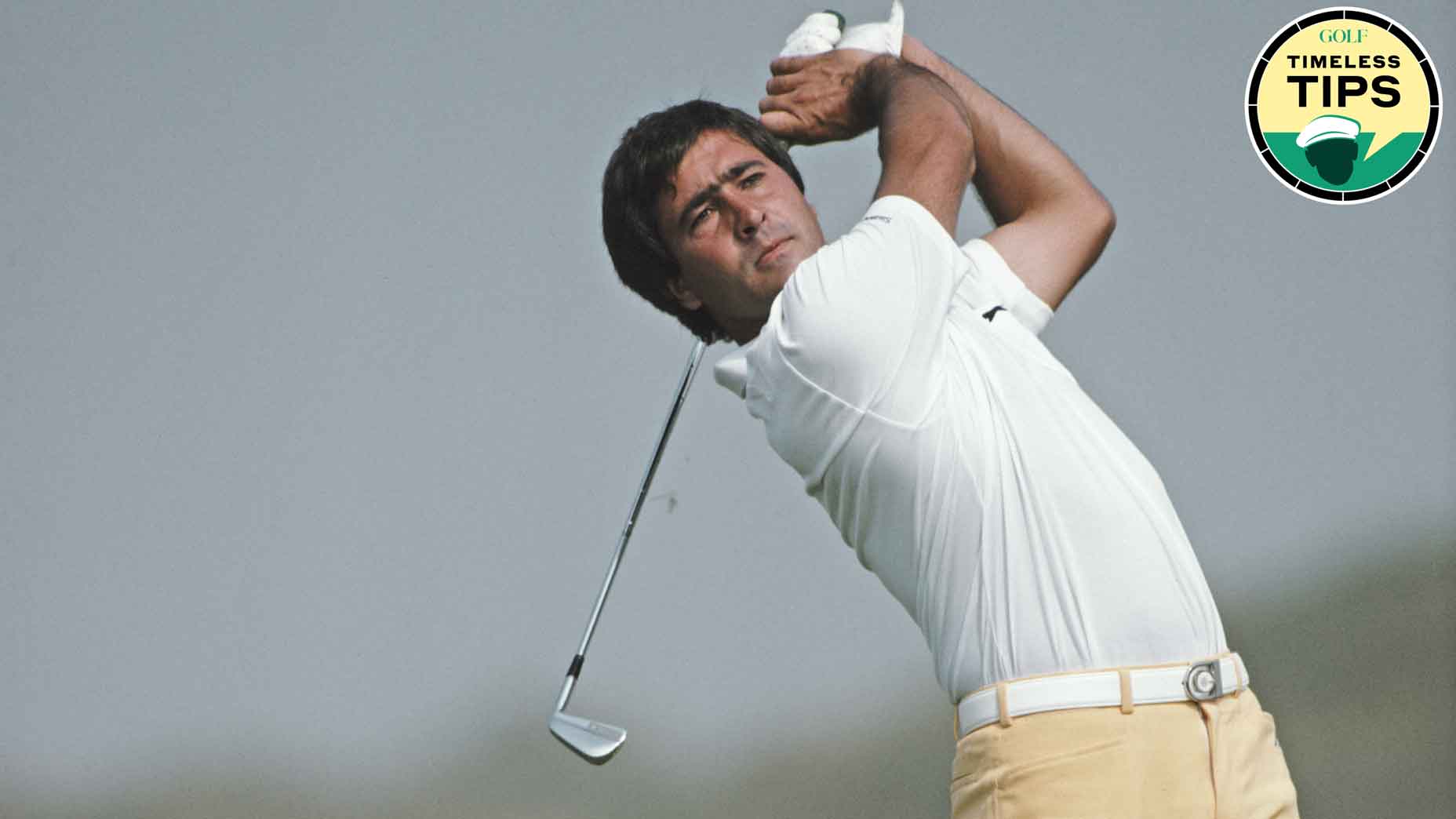Zephyr Melton
Seve Ballesteros was one of the greatest shot-makers of all time.
Getty Images
Golf instruction is ever-evolving, but the best advice stands the test of time. In GOLF.com’s new series, Timeless Tips, we’re highlighting some of the greatest advice teachers and players have dispensed in the pages of GOLF Magazine. Today we turn the pages back to our April 1984 issue when Seve Ballesteros shared his secrets for becoming an elite shot-maker. For unlimited access to the full GOLF Magazine digital archive, join InsideGOLF today; you’ll enjoy $140 of value for only $39.99/year.
Some golfers are scientists and others are artists. Seve Ballesteros planted his flag firmly in the latter category.
There were few shots the fearless Spaniard wouldn’t attempt. No matter the lie, weather conditions or situation, Ballesteros attacked every shot with reckless abandon. In an era defined by shot-makers, Seve stood out among the rest.
Back in April 1984, Ballesteros joined GOLF Magazine to share some of the secrets to his shot-making. Check ’em out below.
Seve’s secrets to shot-making
Shot-making is an art that any player can learn. The simplest way to teach yourself the different swings needed to hit different shots is by working with the most versatile club in the bag — the 5-iron.
In my own case, my first club was a 3-iron, but if I had to do it over, I would pick a 5-iron. The 5-iron is slightly shorter, making it easier to control. At 37 1/2 inches, it’s the perfect length to learn both longer and shorter swings. Both techniques are necessary to become a shotmaker. Its substantial loft also removes fears of mishits. This allows you to swing confidently while working with the various shots.
Following is a description of six shots you can hit with the 5-iron, and keys for playing each.
Long loft
Address: Play the ball just to the right of center and align your feet, hips and shoulders square to the target line. Balance your weight evenly on both feet. Grip normally and lay the blade open “a hair.”
Backswing: Drag the clubhead along the target line with firm wrists and allow your weight to shift laterally to the right. When you feel the weight shift to the inside of your right foot, permit your wrists to break. Turn fully, transferring your weight to the right heel.
Downswing: Drive your knees toward the target and swing the club down with your hands and arms. Keep more weight on your right foot and your head behind the ball so that you contact the ball on the upswing.
Soft fade
Address: With the ball forward, stand open and set your hips, shoulders and the clubface to the left of the target. Hold the handle “firmer” with a “weaker” grip. Put the majority of weight on your left foot.
Seve Ballesteros’ 3 approach shots to master for making more birdies
By:
Zephyr Melton
Backswing: Keep your head “quiet,” eyes focused on the back of the ball, and lower body relatively still, as you swing the club back slower than normal, outside the target line. Once weight shifts to your right foot, allow your wrists to break so you can pull the club up steeply to the three-quarter position.
Downswing: To achieve a “floating” left-to-right ball flight, keep the majority of your weight on the right foot and pull the clubface into the back of the ball from outside to inside the target line.
Running draw
Address: Shut the clubface slightly or drastically, depending on the degree of draw you intend to achieve. Hold the club lightly, with a “stronger” grip. Play the ball back in the stance and align your feet, hips and shoulders to the right of your intended target. Balance your weight.
Backswing: Keep your head steady and swing the club back on the normal “inside” path. Pull the left shoulder under your chin and shift weight to your right heel to enable you to achieve a full backswing.
Downswing: Shift weight to the ball of your left foot. As you pull the club into the hitting area, allow your right hand to cross over your left and your left foot to roll over toward the target. Continue rolling the hands through impact.
Low lash
Address: Stand squarely, putting most of your weight on the left foot. Play the ball back in the stance, nearer your right foot, so your hands are ahead of the clubhead. Choke down for control, grip normally and point the clubface at your target.
Backswing: Keep your head steady and weight left as you swing the club back to the halfway point with your hands and arms.
Learn Seve Ballesteros’ 3 clutch shots to work magic around the greens
By:
Zephyr Melton
Downswing: Think short finish. Now drive both knees toward the target and roll weight to the outside of your left foot to increase your arm speed and clubhead acceleration. Grip tighter and pull the clubhead into the back of the ball so that the back of your left hand is facing the target at impact.
Trap run-through
Address: Play the ball back considerably, stand open “a hair” and put the majority of your weight on the right foot. Keep your head steady and tilt your chin to the right so you look down directly at the ball with your left eye. Pretend that the shot is longer than it actually is to allow for the ball losing speed when it runs through the trap; the more sand, the harder the hit.
Backswing: Keep your head still, knees locked and weight right. Pick the club up steeply with your hands and arms and allow the wrists to break. Swing the clubhead back to waist height.
Downswing: Keep your head steady, drive your right knee inward and pull the clubface into the back of the ball.
Mini-punch
Address: Play the ball forward, nearly off your left big toe. Set your feet, hip and shoulders left of the target line, put the majority of your weight on the left foot and keep your head behind the ball.
Backswing: Keep your head still, eyes focused intently on the ball, and weight left. Pick the club up steeply, breaking your wrists immediately in the takeaway. Swing the club back to the half-swing position with your hands and arms.
Downswing: Remain flat-footed and keep your head steady as you drive your knees toward the target. By maintaining knee action, you will “time” the shot better. Loosen your grip considerably so that the club “snaps” back and the blade “drops” onto the back of the ball.

Zephyr Melton
Golf.com Editor
Zephyr Melton is an assistant editor for GOLF.com where he spends his days blogging, producing and editing. Prior to joining the team at GOLF, he attended the University of Texas followed by stops with the Texas Golf Association, Team USA, the Green Bay Packers and the PGA Tour. He assists on all things instruction and covers amateur and women’s golf. He can be reached at zephyr_melton@golf.com.



